steam power in the 19th century
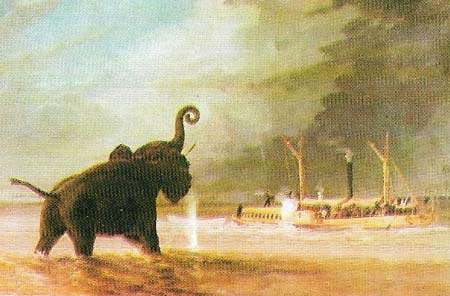
Figure 1. Small steamboats played an important part in the exploration of Africa between c. 1855–1885, and thereafter in the policing and administration of colonial territories. In this steam launch, the Ma-Robert, David Livingstone explored the Zambezi in 1850. He explored the River Rovina in the steam launch Pioneer in 1860. Four years later H. M. Stanley used the steam Launch Lady Alice to circumnavigate Lake Victoria and help in the search for the source of the Congo. Colonial administrators in West Africa used steam launches between railheads up and down the Senegal and Niger rivers.
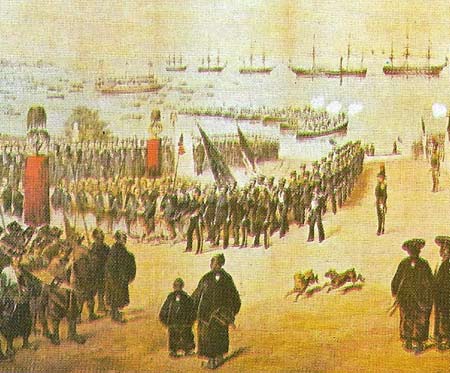
Figure 2. Steam-powered warships were used by Western powers to drag Japan out of her long sustained policy of isolation. In July 1853, fearing that unless he acted quickly Russia would forestall him, the President of the USA sent commodore Matthew Perry with four warships (two were steamers) to Uganda with a letter addressed to the shogunate demanding trade concessions, including coaling stations, in February 1854, Perry returned with seven ships, insisting on a reply. Overawed by the "black ships" in the harbor, the shogunate yielded. The Treaty of Kanazawa, signed on 31 March 1854, opened two ports to US ships.
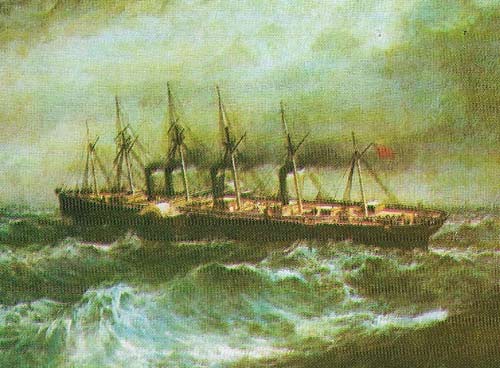
Figure 3. The Great Eastern of 18,915 tons, 210.9 m (685 ft) long and powered by paddle, screw and sail, was too large for weak contemporary marine engines. In July 1866 she laid the first successful transatlantic telegraph cable.
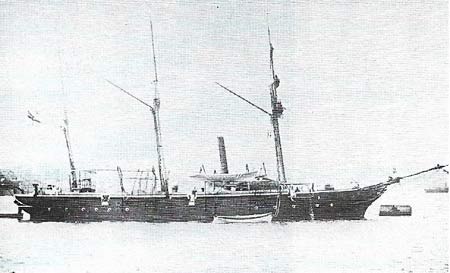
Figure 4. Gunboat Foxhound served in the Royal Navy from 1877-1890. Built to a length of 38.1 meters (41.5 feet), a beam of 7.16 meters (8 feet) and tonnage of 445, she carried two 60-pounder and two 20-pounder guns and could sail towards trouble faster than major capital ships. Small frigates steamed into harbours and even up estuaries to devastate enemies. It was ships of these relatively small sizes that made Britain mistress of the seas in the years before 1914.

Figure 5. The agricultural application of steam power is indicative of nineteenth-century enthusiasm for its uses. Steam plowing was never extensively used because it was cumbersome and the difficulties of fueling with coal added to the cost of its operation. It was most popular in the corn lands of eastern England, where over 80,900 hectares were steam ploughed during the 1860s.
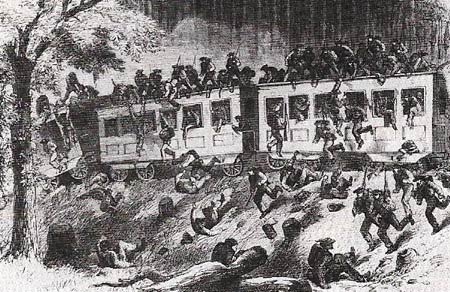
Figure 6. The American Civil Was (1861–1865) was the first major war in which railways played a decisive role. Here, a train bringing Union reinforcements to General Johnston has run off the track in the forests of Mississippi (1863). In Virginia, some railway tracks were blown up and relaid as many as six times during the fighting. The repair gangs worked in sight of the enemy's artillery.
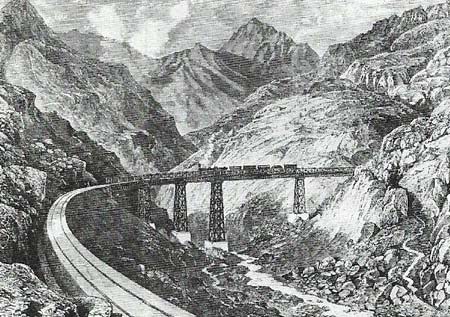
Figure 7. The Chilean railway from Valparaiso to Santiago was built between 1853 and 1864 and was the first important South American railway. Its construction through the Andes represented a great engineering feat, and was financed largely by British investment. Such railways brought development to remote areas, encouraged greater administrative centralisation in previously disunited countries and focused nationalist aspirations.
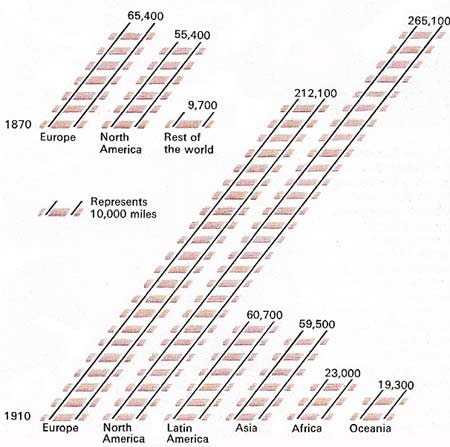
Figure 8. Steam railways were pioneered by Great Britain and the USA. The world's first fully locomotive-powered public railway, the Liverpool and Manchester (1830), was quickly followed by the Baltimore and Ohio and other lines. For the next 40 years railway building was mainly concentrated in Europe and North America, where capital and engineering skill were available, linking centers of industry and commerce. From 1832–1838 railways were started in France, Belgium, Bavaria, Austria, and Canada. After 1870, railways on the American continent were often built to open up new land and to develop its commercial potential. Railways in Japan and India dominated rail construction in Asia.
The application of steam power in the course of the nineteenth century to land and water transport and to manufacturing and agriculture (Figure 5) transformed the world trading system. Steam power also enormously increased the mobility and economic dominance of the most advanced Western nations over the economically backward territories of the earth. Of all the agencies of change, railways had the largest impact.
Nationalism and the railways
In the first stage of their development, until about 1870, railways served to strengthen and enlarge national markets and to consolidate national states. The opening of the first transcontinental railway in 1869 linked with "hoops of iron" the state of California to the rest of the USA. The unification of both Germany and Italy and the growth of their national economies were accelerated by means of the railway. The condition laid down by the Maritime Provinces (Nova Scotia, New Brunswick, Prince Edward Island and Newfoundland) for their acceptance of Canadian Confederation in 1867 was that a railway should be built to link them with the provinces of the interior. A similar condition was laid down by British Columbia when it joined the confederation in 1871.
Later railway developments had a bigger impact on the world economy, especially in greatly increasing the volume of commodity exchange. The extension of railways into the prairies of North and South America through such agencies as the Canadian Pacific Railway and the Argentine Railway, the opening of the "western windows" of Russia – Riga and Odessa – through railways stretching into their wheat-growing hinter-lands, and the construction of lines into the fertile plains of the Punjab and of Bengal, all contributed handsomely to the expansion of world markets in basic commodities.
Before the railway age national economies were largely self-sufficient, but in the age of steam the importation of vast quantities of basic foodstuffs and essential raw materials by the advanced industrial nations enabled them to concentrate on the large-scale, steam-powered production of standardized manufactured goods.
The raising of funds for building steam railways was one of the most important reasons for the growth of a world capital market, with London as its leading center before 1914. Of the £4,107 million British investors had placed overseas by 1914, £1,531 million was in railway securities.
Migration and colonialism
Steamship and railway companies both stood to gain by encouraging the mass migration of labor. Many companies preferred to carry migrants, who loaded and unloaded themselves, rather than cargo that did not. The steerage fare from Liverpool to New York in the 1880s was only £3. More than 20 million people emigrated to the United States between 1865 and 1914.
Without the aid of the gunboat (Figure 4) and the railway, military and political domination of colonial territories by the metropolitan powers would have been impossible (Figure 2). In the 1880s the French sent several military expeditions to Algeria to suppress a serious insurrection under Bu Amama. The uprising was eventually subdued by the building of a railway through the heart of the troubled area. Following the suppression of an Ashanti rebellion by the British in 1900, the pacification of the Gold Coast was sealed by building a railway. Once colonial rule was established, railways reduced administrative expenses in the transport of personnel and stores. A train of the 1890s could do the work of 13,000 porters at five per cent of the cost.
Before the 1860s steamships had a voracious consumption of coal, which limited their range of economic operations to coastal and short sea routes. (The North Atlantic, with a large passenger traffic, was an exception.) Technical improvement came more slowly to the marine engine than the locomotive. In 1840 the 1,139-ton Britannia carried only 90 passengers and only 225 tons of goods because it needed 640 tons of bunker fuel for the Atlantic crossing. But the introduction of the compound marine engine in the 1860s made a 40 percent saving in fuel consumption. In 1914 the 4,556-ton Cunarder Bothnia carried more than three times as much cargo as coal and had room for 340 passengers. With the opening of the Suez Canal in 1869 it was profitable to use compound-engined steamships in the Far East trade.
The use of steel in ship construction in the 1880s and the introduction of the steam turbine in the following decade drove sailing vessels off the sea lanes to Australia and New Zealand. These advances also led to the increase of freight carried in the world's steamships from 27 million tons in 1873 to 63 million tons in 1898.
Industry and agriculture
Before 1914 the use of steam power for driving textile machinery was still heavily concentrated in Western Europe and the USA, which together accounted for 80 percent of factory textile production. But its dispersion had produced rapid advances in industrialization in India, Japan, Australia and Egypt. Steam power was used at all stages in the production of iron and steel, but dispersion of steam power outside the older industrial areas was slow. Steam's biggest impact agriculturally was on the processing of agricultural produce as in threshing.
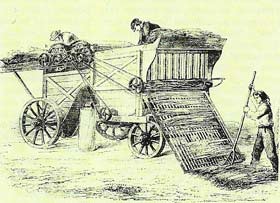 |
| This steam-driven threshing machines displaced the primitive flail during the 1830s. This was steam's most dramatic control agriculture – the one important incursion of steam power into an industry that remained largely unmechanised until the introduction of the petrol engine. |
